She brought hope and dignity to the working women of Belfast


I’ve seen it only as a photograph but it’s a beautiful piece of art featuring female mill workers whose contribution to the success of the city generations ago is rarely taught in our schools today.
During my years as a journalist in the city in the 1970s I learned of women like Sadie Patterson and May Blood who dedicated their lives to making life better for female workers. Those who followed in their shoes, in particular the late Inez McCormick, took equality to a new level fighting long and hard for equality legislation. These women deserve our thanks.
Advertisement
Hide AdAdvertisement
Hide AdYet in all the admiration which the window no doubt will attract I hope someone will remember the role played by one Belfast woman back in the late 1700s who despite a great personal tragedy fought for rights and improved working conditions for impoverished women workers in the city and beyond.


She was the real pioneer and I remember her as we approach the controversial Easter Rising celebrations.
Mary Ann McCracken was born on July 8, 1770, the granddaughter of Francis Joy who established this newspaper in 1737. Mary could have chosen a life of idleness, attending balls and soirees, mixing with the gentry of the city.
Instead she was more interested in the ideals of her contemporaries like Mary Wollstonecraft who was appalled at the idleness of the period’s fashionable young women.
Advertisement
Hide AdAdvertisement
Hide AdBelfast’s industrial revolution was beginning and Mary Ann was horrified at how the “poor destitute women of Belfast’’ were treated.


Aged 22, living in Belfast’s Rosemary Lane and with her own money and help from her sister Margaret she began a muslin business to provide work for some of these women.
In those days the poor lived desperate lives when food was scarce and a place to live in hard to come by.
Winters could be harsh. The rich occasionally opened food kitchens for them but Mary wanted women to be able to earn their own money. She wrote letters to the News Letter pleading for mill owners to keep floors clean and, if possible, to provide warm coats for workers. She was in the vanguard of the emancipation of women.
Advertisement
Hide AdAdvertisement
Hide AdShe paid her workers even when some of them were arrested – it was the years just prior to the 1798 rebellion – and unrest was everywhere. No one tried harder than Mary Ann who had delicate health herself, to alleviate the “endless drudgery’’ destitute workers faced to keep body and soul together.
The weavers were her main concern. She despaired of the disabilities suffered by workers. The political struggles of the day were also difficult to cope with but she appeared to accept that armed rebellion was inevitable. It was to take the life of her precious brother.
Henry Joy McCracken (she called him Harry), the most famous of the northern leaders of the Irish Rebellion of 1798 was fighting for political equality and Mary supported him to the hilt.
In 1798 she walked with him to the gallows in the city centre but he wouldn’t let her see his execution insisting she walk away and he watched her go. It was a ghastly episode in Irish history, if not a much more honourable effort than the 1916 rising which in its first few days developed into a looting spree.
Advertisement
Hide AdAdvertisement
Hide AdYet Mary Ann emerged from it stronger. By 1809 her muslin business was in a small factory in Waring Street and the McCracken sisters worked hard to safeguard employment for their workers.
In the years to come Mary Ann became involved in social reform getting involved with the Belfast Poor House inmates. She was secretary of the Belfast Charitable Society for 25 years. As you look and admire this most recent tribute to those who struggled for working women remember Mary Ann McCracken the woman who helped make it all happen and who died 150 years ago this year.